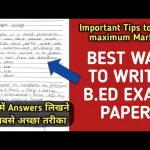The Primary 2 Maths exam is a key part of a child’s early education. It checks how well kids understand basic math concepts like addition, subtraction, shapes, and simple measurements.
This exam helps teachers see what students are good at and what they might need more help with.
1. Addition and Subtraction
Q1: 15 + 7 = ? A1: 22
Q2: 23 – 8 = ? A2: 15
Q3: 9 + 12 = ? A3: 21
Q4: 20 – 5 = ? A4: 15
2. Multiplication and Division
Q5: 5 × 3 = ? A5: 15
Q6: 4 × 2 = ? A6: 8
Q7: 12 ÷ 3 = ? A7: 4
Q8: 20 ÷ 4 = ? A8: 5
3. Counting and Number Patterns
Q9: What number comes after 45? A9: 46
Q10: Fill in the blank: 16, 18, 20, __, 24. A10: 22
Q11: Count by twos: 2, 4, 6, __, 10. A11: 8
Q12: What number comes before 30? A12: 29
4. Shapes
Q13: How many sides does a triangle have? A13: 3
Q14: How many corners does a square have? A14: 4
Q15: What shape has no corners and no sides? A15: Circle
Q16: How many sides does a rectangle have? A16: 4
5. Measurements
Q17: Which is longer: 5 cm or 10 cm? A17: 10 cm
Q18: How many minutes are in one hour? A18: 60 minutes
Q19: Which is heavier: 1 kg or 500 g? A19: 1 kg
Q20: How many days are in a week? A20: 7 days
6. Time
Q21: What time is it if the clock shows 3:00? A21: Three o’clock
Q22: What time is it if the clock shows 7:30? A22: Seven thirty
Q23: How many hours are in a day? A23: 24 hours
Q24: If you go to bed at 8:00 PM and wake up at 6:00 AM, how many hours did you sleep? A24: 10 hours
7. Simple Word Problems
Q25: Tom has 5 apples. He buys 3 more. How many apples does he have now? A25: 8 apples
Q26: Sarah had 12 candies. She gave 4 to her friend. How many candies does she have left? A26: 8 candies
Q27: There are 5 ducks in a pond. If 2 more ducks join them, how many ducks are there now? A27: 7 ducks
Q28: A box contains 10 red balls and 5 blue balls. How many balls are in the box? A28: 15 balls
8. Comparing Numbers
Q29: Which is greater: 25 or 30? A29: 30
Q30: Which is smaller: 14 or 19? A30: 14
Q31: Put these numbers in order from smallest to largest: 9, 4, 12, 7. A31: 4, 7, 9, 12
Q32: What is the largest number: 11, 15, or 13? A32: 15
Importance of Primary 2 Maths Exam
The Primary 2 Maths exam serves several key purposes:
- Assessment of Fundamental Skills: It evaluates students’ grasp of basic mathematical concepts, ensuring they have a solid foundation for more advanced topics in later years.
- Identification of Strengths and Weaknesses: The exam helps identify areas where students excel and where they may need additional support or practice.
- Preparation for Future Exams: Performing well in Primary 2 Maths builds confidence and sets the stage for success in subsequent academic assessments.
- Development of Problem-Solving Skills: The exam encourages logical thinking and problem-solving, essential skills in both academics and everyday life.
Curriculum Overview
The Primary 2 Maths curriculum covers a range of topics designed to build a strong mathematical foundation. Key areas include:
1. Numbers and Numeration
- Counting and Number Recognition: Understanding numbers up to 100, recognizing number patterns, and mastering forward and backward counting.
- Place Value: Comprehending the concept of tens and ones, and learning to represent numbers using place value.
2. Addition and Subtraction
- Basic Operations: Performing addition and subtraction within 100, understanding the relationship between the two operations.
- Word Problems: Solving simple word problems involving addition and subtraction to develop analytical skills.
3. Multiplication and Division
- Introduction to Concepts: Gaining a basic understanding of multiplication and division through repeated addition and sharing.
- Times Tables: Learning multiplication tables for numbers up to 5.
4. Geometry
- Shapes and Space: Identifying and naming common 2D and 3D shapes, understanding their properties and spatial relationships.
- Symmetry: Recognizing symmetrical shapes and understanding the concept of symmetry.
5. Measurement
- Length, Weight, and Capacity: Using standard units of measurement (cm, m, kg, g, l, ml) to measure and compare objects.
- Time: Reading and understanding clocks, learning about hours, minutes, and seconds.
6. Money
- Currency Recognition: Identifying coins and notes, understanding their values.
- Simple Transactions: Performing basic transactions involving addition and subtraction of money.
7. Data Handling
- Graph Interpretation: Reading and interpreting simple bar charts and pictograms.
- Data Collection: Collecting data and organizing it into tables and charts.
Preparation Strategies
Effective preparation is key to performing well in the Primary 2 Maths exam. Here are some strategies to help students prepare:
1. Consistent Practice
- Daily Practice: Regular practice of mathematical problems reinforces learning and builds confidence.
- Variety of Problems: Exposure to different types of problems ensures a well-rounded understanding of concepts.
2. Use of Visual Aids
- Manipulatives: Tools like counters, number lines, and base-ten blocks can make abstract concepts more concrete.
- Charts and Diagrams: Visual aids help in understanding shapes, measurements, and data handling.
3. Interactive Learning
- Educational Games: Math-based games and apps can make learning fun and engaging.
- Group Activities: Collaborative activities encourage discussion and enhance problem-solving skills.
4. Real-Life Application
- Practical Examples: Relating math to everyday activities (e.g., shopping, cooking) helps students see the relevance of their learning.
- Hands-On Activities: Engaging in activities like measuring objects or counting money can reinforce concepts.
Tips for Success
To excel in the Primary 2 Maths exam, students should keep the following tips in mind:
1. Understand the Concepts
- Focus on Understanding: Rather than rote memorization, emphasize a deep understanding of mathematical concepts.
- Ask Questions: Encourage curiosity and clarify doubts promptly.
2. Practice Time Management
- Timed Practice: Solve practice papers within a set time to improve speed and accuracy.
- Prioritize Questions: Learn to identify and tackle easier questions first to ensure maximum marks.
3. Review Mistakes
- Analyze Errors: Review incorrect answers to understand mistakes and avoid repeating them.
- Seek Help: Don’t hesitate to ask teachers or parents for help with challenging problems.
4. Stay Positive and Relaxed
- Positive Attitude: Maintain a positive outlook towards the exam to reduce anxiety.
- Relaxation Techniques: Practice breathing exercises or mindfulness to stay calm during the exam.
Latest Posts
- Step-by-step guide to download and apply for jee mains admit card 202
- Comprehensive 2025 government holidays and recruitment details for job seekers
- JEE Mains Admit Card 2025: Your Step-by-Step Guide to Downloading the Hall Ticket
- Everything You Need to Know About 2025 Government Holidays Recruitment
- Comprehensive Guide to rrb d group recruitment 2025 – Eligibility, Vacancies, and Application
- Detailed guide to nps trust recruitment 2025 vacancies, eligibility and apply process
- Comprehensive guide to hpcl recruitment 2025 notification, vacancies, and application process
- ignou bed admission 2025 complete recruitment guide with eligibility and process
- Comprehensive Guide to Indian Army Agniveer Recruitment 2025 Notification and Jobs
- Everything You Must Know About CBSE Board Exams 2025 Changes & New Rules



